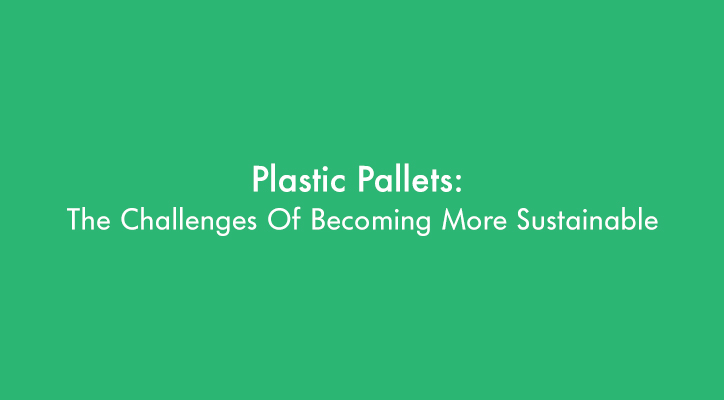Plastic Pallets: The Challenges Of Becoming More Sustainable
09 Jul 2019

Corporate responsibility and sustainability have been hitting the news lately and rightly so. It’s hard to emphasise the importance of everyone, from individuals, small and medium sized businesses to large multinational corporations doing their bit to reduce the effects of climate change.
Every day millions of companies and individuals send and receive goods. Goods which are usually shipped around the world on pallets.
They might be wooden pallets or they might be plastic pallets.
But they’re definitely some kind of pallet.
When you’re transporting masses amounts of pallets around the globe you’re going to incur costs and create emissions. There’s no real way around that at the moment.
The heavier something is and the more space it occupies the higher the cost and larger the emissions. a
Both plastic and wooden pallets have different impacts and benefits. But in this guide we’re going to be exclusively looking at plastic pallets can help your business be more sustainable.
So without further ado, let’s delve into the world of plastic pallets and sustainability.
CONTENTS
Chapter One: The Current Challenges Facing The Shipping & Logistics Industry
Chapter Two: The Challenges Facing Businesses
Chapter Three: How Plastic Pallets Can Provide The Answer
Chapter Four: Other Things To Consider Before Investing In Plastic Pallets
Chapter Five: What Does The Future Hold?
Chapter: Six: Conclusion
Chapter One: The Challenges Facing The Shipping & Logistics Industry
There are many different challenges facing the shipping and logistics industry.
Increasing transport costs
One of the bigger challenges is the increasing cost of transportation. With the prices of fuel increasing and uncertainties around future fuel costs rife thanks to Brexit.
Environmental regulations
There are also recent government and environmental regulations which are impacting the logistics industry. With governments enforcing increasingly strict regulations regarding emissions it can be tough for businesses to stay up to speed and remain profitable.
Supplier and partner relationships are also a big component in potential challenges for the logistics industry.
Its vital for suppliers and partners to have and follow mutually agreed upon standards to ensure strong performance and identify opportunities for improvement.
Consumer behaviour
The general zeitgeist has seen a massive switch in consumer and supplier behaviour. There is a much deeper preference towards sustainable and environmentally friendly practices. This means organisations need to be accountable and put in place sustainable processes which are usually more expensive.
All of these challenges facing the logistics industry obviously have an effect on the pallet industry, as the two are so deeply connected.
There is pressure on pallet providers to provide more environmental and sustainable pallets without drastically increasing prices which are already rising for the logistics industry.
With Brexit still unclear there is also concern around the suitability of different pallets and what may happen based on the deal which is agreed.
Chapter Two: The Challenges Facing Businesses
Having discussed the various challenges facing the logistics and shipping industry we need to talk about which areas companies need to improve on.
First up is the supply chain.
Supply Chain Challenges
Due to globalisation supply chains have become more complex than ever before. Therefore they are more expensive than ever. This is a prime reason for many organisations outsourcing their supply chain to countries with cheaper labour costs.
However this promotes its own set of problems which is where organisations need to improve.
With an extended networked global supply chain there are many more things that need to be managed. However this can be overcome with data management and integration.
There are many other areas in which organisations need to improve.
Environment Challenges
For instance organisations need to focus on improving the impact they have on the environment. Organisations worldwide have been tasked with reducing their effect on the environment and improving their practices and processes to be more friendly to the planet.
Spirallying shipping costs are also another important challenge facing the industry. With fuel prices increasing and stricter regulations coming in to force the cost of shipping pallets. Especially large loads of pallets around the planet is increasing.
Chapter Three: How Plastic Pallets Can Provide The Answer
As we have just touch on some key issues like environmental impact and supply chain inefficiencies that need to be improved.
One way of doing this is through the use of plastic pallets.
Good for the environment
Whilst some argue that plastic pallets aren’t good for the environment when compared with wooden pallets which biodegrade.
However, that is far from the truth.
One of the key things in favour of plastic pallets is their remarkable life span. Unlike wooden pallets that can breakdown relatively easy and may therefore have a short life span (unless repaired and refurbished) plastic pallets can have a lifespan of up to ten years.
That means that one plastic pallet could be used it its life cycle many more times than any given wooden pallet.
Good for supply chains
Plastic pallets are also great for improving supply chain inefficiencies.
First of all plastic pallets aren’t governed by the same ISPM 15 heat treatment regulations like wooden pallets. This automatically speeds things up somewhat. It also makes them the go to pallet for industries like pharmaceuticals and food.
They will also create a long term cost saving as one plastic pallet lasts much longer than any given wooden pallet.
Plastic pallets are also great at maintaining high standards of hygiene and are easily cleaned unlike wooden pallets. This can help speed things up if there are any spillages or mishaps during transit.
Plastic pallets are also generally lighter than their wooden counterparts which means quicker and cheaper travel. Also unlike wooden pallets (excluding presswood pallets) plastic are generally good at saving space.
All of these features are great for improving supply chain inefficiencies.
Chapter Four: Other Things To Consider Before Investing In Plastic Pallets
In addition to the above benefits to the environment and supply chains plastic pallets also offer many more benefits for investing in them.
Safe to handle
Unlike wooden pallets which can often splinter and have protruding nails, plastic pallets are smooth and much safer to handle.
As plastic pallets are created through moulding plastic in various ways they don’t run the risk of having rusty nails, splinters, sharp edges etc.
Branding and marketing tool
Another often overlooked benefit of plastic pallets is that they can be used as a branding and marketing tool. More often than not plastic pallets are more aesthetically pleasing than their wooden counter parts. Available in different colours they can also be customised and used for displays.
Dimensional stability
Plastic pallets are also very dimensionally stable. This means that no matter what their load is their dimensions won’t change. This ensures consistency with storage when transporting goods. Their width, length and height won’t change under an appropriate load.
Work in all weather conditions
Unlike some wooden pallets plastic pallets cope very well in different weather and environmental conditions. Plastic pallets are waterproof which helps make them resistant to mold and corrosion. They’re also usually resistant to shock, stress, weak acids and alkalis.
Plastic Pallet Benefits
These benefits and the ones outlined in the previous chapter make plastic pallets a worthwhile investment.
They’re strong, last a long time, are good for the environment, can be stacked and are lightweight. All the advantages make them great for improving supply chain efficiency and improving sustainability.
Chapter Five: What Does The Future Hold?
Over the last few years there have been many in depth reports and studies into the health of the pallet industry.
They have commented on its current performance and forecast future growth for the plastic pallet market.
Here are some highlights which demonstrates the future of the plastic pallet industry.
First of all the global pallet market is set to increase in value to $73.84 billion by 2025.
Growth is primarily being driven by a pickup in manufacturing and retail sectors. Especially larger and more developed markets which shift towards higher priced plastic pallets.
It is thought that this growth in manufacturing is being driven by already established markets such as America and Western Europe.
This increase in demand is set to advance by 5.48% per annum through to 2025.
Furthermore over the next six years the majority of the pallet demand and production is expected to continue to focus on wooden pallets.
However the demand for plastic pallets is growing faster than any other type of material in most national markets.
Furthermore Asia is identified as the area with the fastest growing market. A large population combined with huge manufacturing growth (China) is predicted to drive demand for plastic pallets in the region.
Chapter Six: Conclusion
Summarise the different challenges facing the industry and how plastic pallets can offer a solution
So hopefully by now you have a good idea of the challenges facing the pallet, logistics and shipping industries.
We’ve delved into the different issues facing organisations and identified areas where improvement is required.
Furthermore we’ve talked about how utilising plastic pallets can actually help with these areas such as environmental impact and supply chain inefficiencies.
Finally you should also have a decent understanding of what the future holds of plastic pallets and where the global pallet industry is heading over the next six years.
